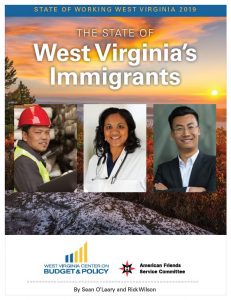 West Virginia’s immigrants come from all over the world and while a small share of the populations, they are broadly represented throughout the state’s workforce and economy. Read PDF of report.
West Virginia’s immigrants come from all over the world and while a small share of the populations, they are broadly represented throughout the state’s workforce and economy. Read PDF of report.
But a fuller conversation about immigrants tends to be overshadowed by the controversy in the U.S. around immigration reform. This conversation all too often tends to paint immigrants as a homogenous group. The conversation ought to reflect an informed understanding of this dynamic population, its diverse contributions to the economy and the challenges immigrants face.
This report attempts to have that deeper conversation, reflecting on the history of immigrants in West Virginia, the challenges they have faced, how they’ve become enmeshed in the fabric of the state, and their role in the state today.
Key Findings
- Immigrants account for less than 2 percent of West Virginia’s population, but growth in the state’s immigrant population has helped slow the state’s population loss.
- About 53 percent of West Virginia’s immigrants are naturalized citizens, while the rest are temporary and permanent legal residents, recently arrived refugees and undocumented immigrants.
- West Virginia’s immigrants come from around the world, and are more diverse the national immigrant population.
- West Virginia’s immigrants are on average, older than U.S. born West Virginians. This appears to be due to a number of factors, including that most immigrants are of prime-working age who come to the U.S. to work, and the children of immigrants are often U.S. born, skewing the average age of immigrants.
- Immigrants’ share in the labor force, small business ownership and economic output all slightly exceed their representation in the population.
- More than half of West Virginia’s immigrants work in white-collar and healthcare related occupations.
- There is some concentration of immigrants in high wage jobs, as well as low wage jobs. The same is true with income.
- Among low income immigrants, many struggle and are often excluded from public support.
- The concentration of immigrants in high income levels is tied to higher levels of education, even though immigrants with a college degree earn less than U.S. born West Virginians with a degree.
- Immigrants are more likely to have a college education than native born West Virginians.
- Poverty rates are slightly higher for immigrants than native born West Virginians.
- Citizenship status is a major factor to immigrants’ economic security.
 West Virginia’s immigrants come from all over the world and while a small share of the populations, they are broadly represented throughout the state’s workforce and economy. Read PDF of report.
West Virginia’s immigrants come from all over the world and while a small share of the populations, they are broadly represented throughout the state’s workforce and economy. Read PDF of report.